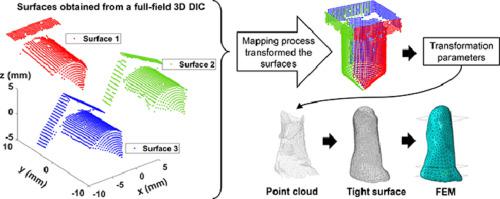Acta Biomaterialia ( IF 9.7 ) Pub Date : 2020-07-08 , DOI: 10.1016/j.actbio.2020.07.003 Rosti Readioff 1 , Brendan Geraghty 2 , Eithne Comerford 3 , Ahmed Elsheikh 4

|
It is limiting to use conventional methods when characterising material properties of complex biological tissues with inhomogeneous and anisotropic structure, such as the anterior cruciate ligament (ACL) in the knee joint. This study aims to develop and utilise a three-dimensional digital image correlation method (3D DIC) for the purpose of determining material properties of femur-ACL-tibia complex across the surface without any contact between the tissue and the loading equipment. A full-field (360° view) 3D DIC test setup consisting of six digital single-lens reflex cameras was developed and ACL specimens from skeletally mature dog knee joints were tested. The six cameras were arranged into three pairs and the cameras within each pair were positioned with 25° in between to obtain the desired stereovision output. The test setup was calibrated twice: first to obtain the intrinsic and extrinsic parameters within camera pairs, and second to align the 3D surfaces from each camera pair in order to generate the full view of the ACLs. Using the undeformed 3D surfaces of the ligaments, ACL-specific finite element models were generated. Longitudinal deformation of ligaments under tensile loads obtained from the 3D DIC, and this was analysed to serve as input for the inverse finite element analysis. As a result, hyperelastic coefficients from the first-order Ogden model that characterise ACL behaviour were determined with a marginal error of <1.5%. This test setup and methodology provides a means to accurately determine inhomogeneous and anisotropic material properties of ACL. The methodology described in this study could be adopted to investigate other biological and cultured tissues with complex structure.
Statement of Significance
Determining the material properties of soft tissues with complex anatomical structure, such as the anterior cruciate ligament (ACL), is important to better understand their contribution to musculoskeletal biomechanics. Current conventional methods for characterising material properties of the ACL are often limited to a contact measurement approach, however an improved understanding of the mechanics of this complex tissue is vital in terms of preventing injury and developing novel therapies. This article reports the development and utilisation of non-contact optical methodology involving full-field three-dimensional digital image correlation and finite element analysis to accurately investigate material properties of the ACL, in a controlled environment. This technique reduces inaccuracies due to specimen clamping and more importantly considers the inhomogeneous nature of the examined tissue.
中文翻译:

全场3D数字图像关联和建模技术,用于表征离体前十字韧带力学。
在表征具有不均匀和各向异性结构的复杂生物组织(例如膝关节前十字韧带(ACL))的材料特性时,使用常规方法是有局限性的。这项研究旨在开发和利用三维数字图像相关方法(3D DIC),以测定整个表面上股骨-ACL-胫骨复合物的材料特性,而组织和加载设备之间没有任何接触。开发了由六个数码单镜头反光照相机组成的全视野(360°视角)3D DIC测试装置,并对骨骼成熟的狗膝关节的ACL标本进行了测试。六个摄像机分成三对,每对中的摄像机之间的夹角为25°,以获得所需的立体视觉输出。测试设置进行了两次校准:首先获取摄像机对内的内部和外部参数,其次将每个摄像机对的3D表面对齐,以生成ACL的完整视图。使用韧带的未变形3D表面,生成了ACL特定的有限元模型。从3D DIC获得的韧带在拉伸载荷下的纵向变形,并进行了分析,以作为有限元逆分析的输入。结果,确定了表征ACL行为的一阶Ogden模型的超弹性系数,其边际误差<1.5%。该测试设置和方法学提供了一种精确确定ACL的不均匀和各向异性材料特性的方法。
重要声明
确定具有复杂解剖结构的软组织的材料特性,例如前十字韧带(ACL),对于更好地了解其对肌肉骨骼生物力学的贡献很重要。当前用于表征ACL的材料特性的常规方法通常仅限于接触测量方法,但是,就预防损伤和开发新疗法而言,对这种复杂组织的力学的更好理解至关重要。本文报道了在可控环境中涉及全场三维数字图像相关性和有限元分析的非接触式光学方法的开发和利用,以准确研究ACL的材料特性。



























 京公网安备 11010802027423号
京公网安备 11010802027423号